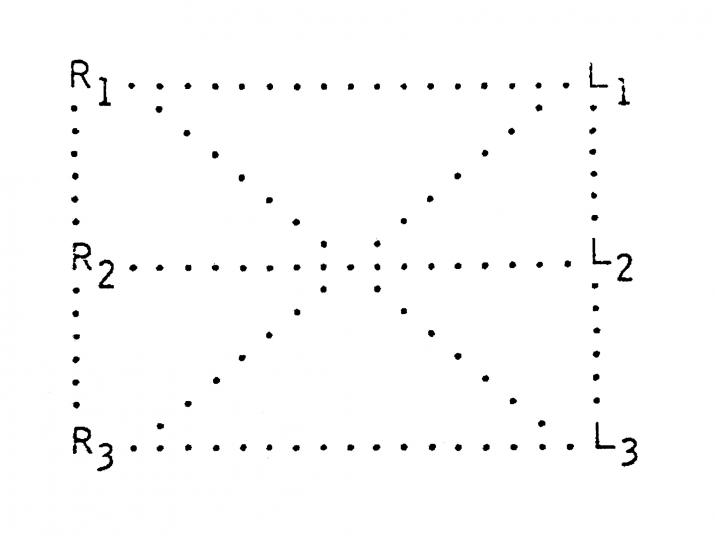
Interpolation of the Enantiomorphic Chambers
1. Code of Reflections:

2. Key to Code:
A. Right (R) corresponds to 1, 2, 3, mirror reflections.
B. Left (L) corresponds to 1, 2, 3, mirror reflections.
3. The chambers cancel out one’s reflected image, when one is directly between the two mirrors.
4. Definition of the enantiomorphic within the context of binocular vision.
A. Any manifest division between the position of the two eyes.
B. Contrary accommodation and convergence.
C. Duplex structure of sight as an invention.
D. Infinite myopia.
E. Equidistant dislocation.
5. The surface plane (fluorescent green) is behind the framing support (blue). One cannot see the whole work from a single point of view, because the vanishing point is split and reversed. The structure is “flat,” but with an extra dimension.
6. To see one’s own sight means visible blindness.
7. “They asked him if he still thought he could ‘see.’ ‘No,’ he said. ‘That was folly. The word means nothing . . . less than nothing!’” The Country of the Blind, H.G. Wells.
PARAGRAPH FROM A FICTIVE ARTIST’S JOURNAL
Once, when I was fortunate enough to gain access to the private art-book library of the late Casper Clamp, I had the privilege of scrutinizing his rare edition of “The Exhaustion of Sight or How to Go Blind and Yet See.” Only six volumes remain of this astounding work. The book’s heavy pages contained intricate diagrams “on seeing sight.” A chapter called “Invisible Orbs,” illustrated special visual conditions known as “lead eyes, ice eyes, pyramidal eyes, and violet eyes.” Much was said about eyeglasses as “a structure supported by the nose and ears.” The few artists that have seen this book, such as Daniel Nivalk and Mary Bone have been in some way altered. Nivalk finds the book “suspect,” but nevertheless agrees that it contains many “hitherto unknown facts about visual acedia.” On the other hand Mary Bone, known in certain circles for her “Smoke on Smoke,” finds Clamp’s book, “the key to flying saucers.” For myself, the book is a true paradigm of unending importance. I look forward to the day when it will be published in “paperback,” so that millions of artists everywhere will be able to share in its many treasures.
Smithson, Robert. "Interpolation of the Enantiomorphic Chambers." Art in Process, Finch College catalog, 1966.


